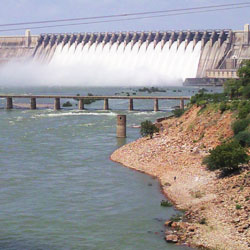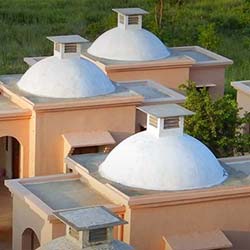
- Home
- Travel Packages
- Top Destination
-
Travel Attraction
By Category
Top Attraction

- Travel Agents
- Car Rentals
- Hotels

About Anupu, Nagarjunakonda Anupu, near Nagarjunakonda in Andhra Pradesh, is an ancient Buddhist site reconstructed to preserve ruins from the submerged Nagarjunakonda valley. It features a majestic amphitheater, viharas, stupas, and intricate carvings reflecting Buddhist architecture. A significant archaeological and historical site, it offers insights into India's rich Buddhist heritage. History Anupu, also known as Nagarjunakonda, is a historical site located in the Indian state of Andhra Pradesh. It was once a thriving Buddhist settlement during the 2nd and 3rd centuries CE. The site is famous for its ancient ruins, including stupas, monasteries, and rock-cut caves, which provide insight into the region's rich cultural and architectural heritage. Architecture and Design The architecture of Anupu reflects the Buddhist influence on the region, with intricately carved sculptures and stone structures. The design of the stupas and monasteries showcases the skilled craftsmanship of the artisans who built them. Visitors can marvel at the intricate details and historical significance of the structures as they explore the site. Best Time to Visit Cultural Significance Anupu holds immense cultural significance as a former Buddhist settlement and a historical site. It is a testament to the region's rich history and religious heritage. The site offers visitors a chance to experience the ancient ways of life and appreciate the architectural and artistic achievements of the past. Pilgrimage Practices Many visitors to Anupu come to pay their respects to the Buddhist monks who once inhabited the site. Pilgrims often engage in prayers and meditation at the various shrines and stupas scattered throughout the area. The tranquil surroundings provide a perfect setting for spiritual reflection and contemplation. Dress Code and Etiquette Visitors to Anupu are advised to dress modestly and respectfully, in keeping with the religious and cultural significance of the site. It is recommended to cover your shoulders and knees and remove your shoes before entering any of the sacred spaces. Visitors are also encouraged to maintain a peaceful and contemplative demeanor while exploring the site. Activities and Experiences Art and Religious Symbols The art and religious symbols found at Anupu are a testament to the Buddhist influence on the region. Visitors can admire the intricate carvings, statues, and paintings that adorn the various structures at the site. These symbols serve as a reminder of the spiritual beliefs and practices of the ancient inhabitants of Nagarjunakonda. Local Insights Local guides and experts at Anupu can provide visitors with valuable insights into the history and significance of the site. They can offer a deeper understanding of the architecture, art, and religious practices of the Buddhist monks who once lived there. Engaging with locals can enhance your experience and appreciation of Anupu's cultural heritage.
Explore More
Nagarjuna Sagar, an erstwhile prominent Buddhist center, is the most attractive tourist spot in Andhra Pradesh. Named after the Buddhist monk, Acharya Nagarjuna, it is today the major hydel power station in Andhra Pradesh. It is the tallest masonry dam in the World, constructed on the river Krishna. Nagarjuna Sagar dam is located on the border of Guntur - Nalgonda districts. The dam was completed in 1966 and it is 124 metres high and 1 km long. It is built across the river Krishna and has one of the largest networks of canal systems irrigating over 2,000,000 acres of land in Guntur, Prakasam, Nalgonda, Khammam and Krishna districts. 4 kms away from the dam, is the viewpoint, where a panoramic view of the amazing landscape, is simply a feast to the eyes. One can find the image of Nagarjuna, on a pylon not too far from the dam.
Explore More
About Dhamma Nagajjuna, Nagarjunakonda History Dhamma Nagajjuna, also known as Nagarjunakonda, is a historical and religious site located in India. It is believed to have been a center for Buddhist learning and practice during the ancient times. The site has a rich history dating back to the 3rd century BC when it was founded by the Mauryan Empire. Over the centuries, it has been a significant pilgrimage site for Buddhists and a place of cultural significance. Architecture and Design The architecture of Dhamma Nagajjuna reflects the ancient Buddhist style with intricately carved pillars, stupas, and viharas. The design of the site is a blend of Indian and Buddhist architectural elements, showcasing the craftsmanship of the artisans of that time. Visitors can marvel at the ancient ruins and appreciate the beauty and symmetry of the structures. Best Time to Visit The best time to visit Dhamma Nagajjuna, Nagarjunakonda, is during the winter months from November to February when the weather is pleasant and cool. The monsoon season from June to September should be avoided as the site can be slippery and prone to landslides during this time. Cultural Significance Dhamma Nagajjuna holds immense cultural significance as a place of Buddhist pilgrimage and learning. It is believed to be the birthplace of the renowned Buddhist scholar Nagarjuna, whose teachings and philosophy continue to influence Buddhists around the world. The site also showcases the rich cultural heritage of ancient India and the architectural prowess of that era. Pilgrimage Practices Pilgrims visiting Dhamma Nagajjuna often engage in rituals such as offering prayers, chanting mantras, and circumambulating the stupas. Many also participate in meditation sessions and attend lectures on Buddhist teachings. Pilgrimage practices at the site are aimed at spiritual growth, enlightenment, and seeking blessings from the Buddha. Dress Code and Etiquette Visitors to Dhamma Nagajjuna are advised to dress modestly and respectfully, covering their shoulders and knees. Shoes are generally removed before entering the sacred spaces, and photography may be restricted in certain areas. It is important to maintain silence and show reverence towards the religious artifacts and structures at the site. Activities and Experiences Visitors to Dhamma Nagajjuna can engage in a variety of activities such as exploring the ancient ruins, attending meditation sessions, and participating in cultural performances. Guided tours are available for those interested in learning more about the history and significance of the site. Visitors can also enjoy boat rides on the nearby lake and soak in the tranquil atmosphere of the surroundings. Art and Religious Symbols The art and religious symbols at Dhamma Nagajjuna reflect the intricate craftsmanship and deep spiritual meanings of Buddhist culture. Visitors can admire the carvings of Buddha statues, lotus flowers, and other symbols of enlightenment. The artwork at the site serves as a visual representation of Buddhist teachings and beliefs, providing a sense of peace and tranquility to visitors. Local Insights Local guides and residents at Dhamma Nagajjuna offer valuable insights into the history, culture, and significance of the site. They share stories and legends passed down through generations, providing a unique perspective on the spiritual and historical importance of the place. Visitors can interact with the locals, learn about their traditions, and gain a deeper understanding of the Buddhist heritage of the region.
Explore MoreTirupati Mangapura 1 Day Package -vip Sheegra Darshana- Pilgrimage Holidays Package from Bengaluru
2 Days/ 1 Night
Tirupati
6 Night - 7 Days Divine South India Tour
7 Days/ 6 Night
Kanyakumari - Madurai - Rameshwaram - Nandyal
Tirupati Balaji 3 Days - 2 Nights Tour
3 Days/ 2 Night
Tirupati - Chennai
1 Night - 2 Day Araku Valley - Beach - Visakhapatnam Tour
2 Days/ 1 Night
Visakhapatnam